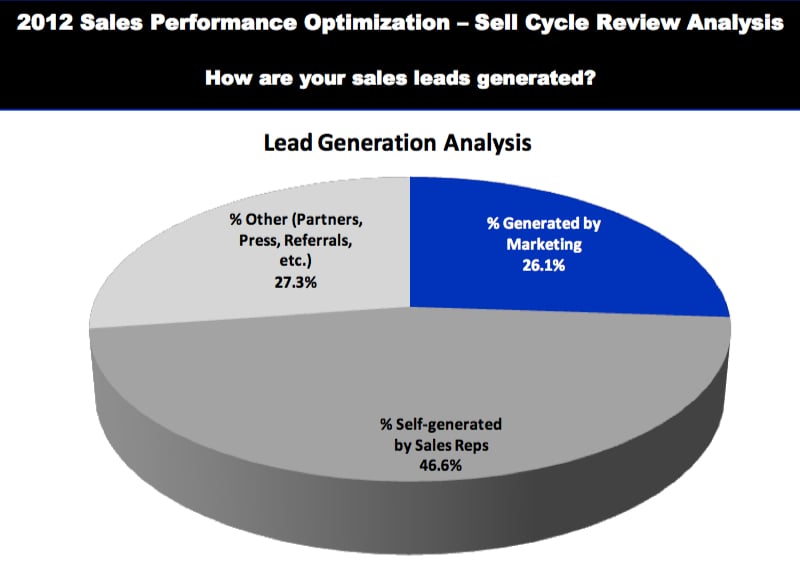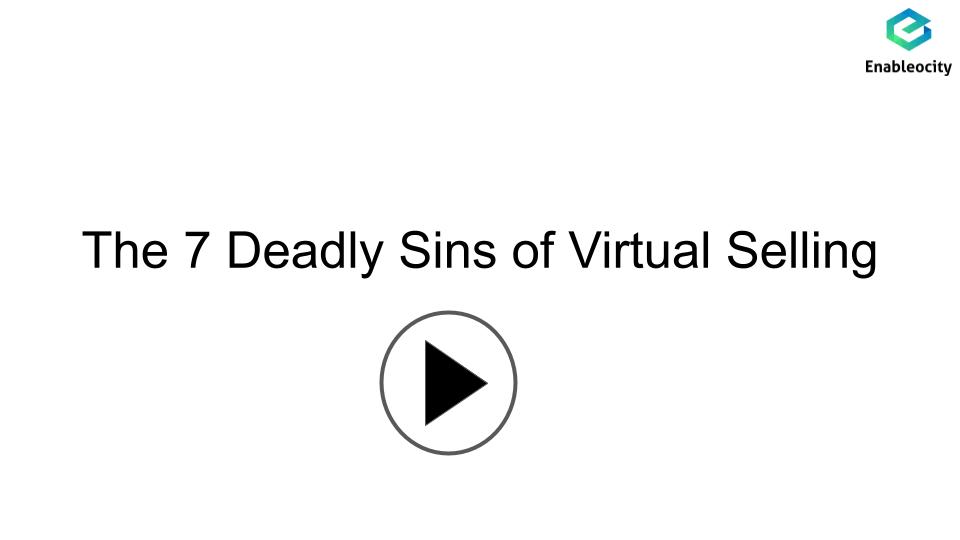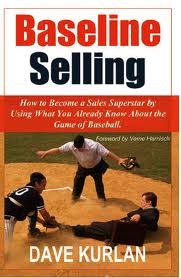This three part blog series started with a guest post on The evolution of marketing and PR, by PR-consultant-turned-inbound-marketer Ellie Becker.
The series continued with a post entitled, B2B Sales in transition, who Needs Salespeople on the changing perceptions and realities of the sales role in the B2B buying process with Mike Bosworth.
The series concludes with a review of what's working in existing sales and marketing methods and the necessary changes in sales training and enablement to build the sales force of the 21st century.
This is not meant to be an exhaustive list, but if you get all of these right, you will be in a great place as a seller or marketer.
What's Working
Inbound Marketing
The sales process starts with a lead, ideally an inbound lead. Inbound Leads are vital and are the lowest cost way of increasing the sales pipeline, but there are many die-hards who insist that lead sourcing is a part of a salesperson's job description and that cold calling is the best method.
Indeed marketing is effective in generating leads in only one in four companies according to CSO Insights. We are still in an early adopter phase of inbound marketing.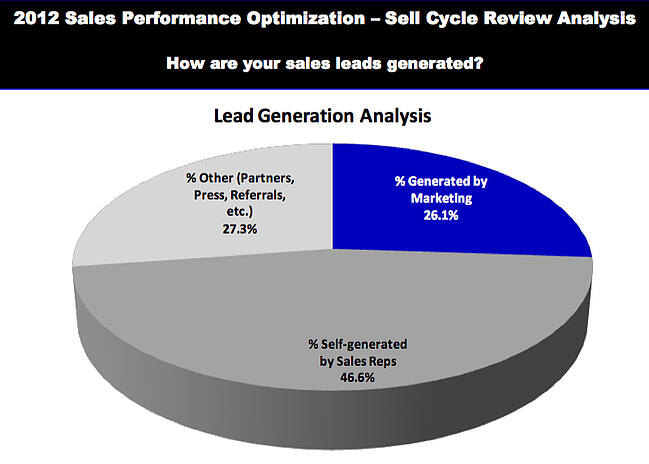
But consider these cold calling statistics:
- 200 million Americans have registered their number on the FTC do not call list.
- Doesn't work 90.9% of the time (Harvard Business Review)
- Costs at least 62% more per lead (HubSpot, The State of Inbound Marketing)
- Has a rate of less than 2% of phone calls resulting in a meeting (Leap Job)
- 88% of buyers will have nothing to do with cold callers (Huthwaite)
- 94% of buyers couldn’t remember a single prospector or message they had received during the last two years (Huthwaite)
I asked our partner John McTigue at leading HubSpot marketing agency Kuno Creative for a comment on what is working with inbound marketing.
Lead Generation, Lead Nurturing and Marketing Automation
Modern marketing agencies and marketing departments leverage inbound marketing strategies to generate qualified leads and nurture them into sales-ready leads.
At the core is content marketing, creating and distributing digital content that is relevant to buyers and helps them solve their problems. Unlike a cold-call, every piece of content published creates a legacy and has the potential to generate traffic and leads for years to come.
The lead generation process begins with top-of-the-funnel content that is educational and/or entertaining. Using search engine optimization techniques and marketing automation systems such as HubSpot, Marketo or Eloqua, marketers distribute this content via email to targeted, opted-in lists, blogs, ppc campaigns and social networks.
Potential buyers convert to leads and opt-in to receive your communication by clicking on optimized calls-to-action and landing pages that appeal to their needs and interests. They are then automatically transferred into lead nurturing workflows that continue to send them relevant follow-up (mid-funnel) information that answers their questions and move them down the funnel, i.e., closer to a buy decision at the bottom of the funnel. 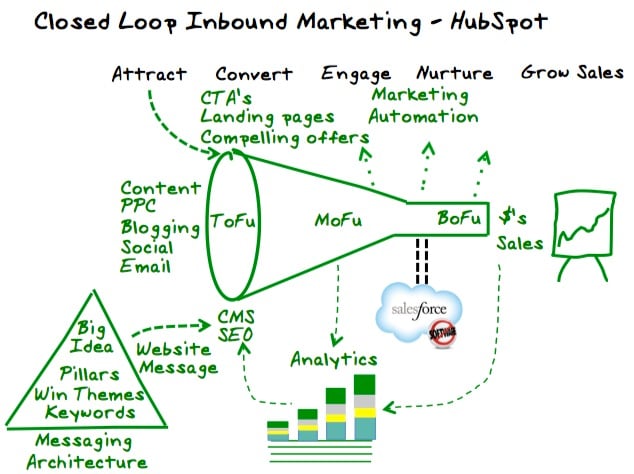
Built-in analytics allows marketers to refine their digital marketing campaigns and further optimize conversion rates. Marketing automation systems also provide them with tools for segmenting, scoring and transferring sales-ready leads into CRM systems for sales team follow-up.
Comprehensive use of inbound marketing strategies and marketing automation tools create value for marketers by:
- attracting higher quality leads into the top of the sales funnel with higher conversion rates,
- reducing lost leads due to inactivity or lack of relevance and
- reducing the cost of customer acquisition by delivering sales-ready leads in a more efficient and more sustainable manner.
To learn more about modern lead generation, lead nurturing and marketing automation, download our Enterprise Lead Nurturing Guide.
Sales and Marketing Messaging Alignment
What makes a compelling sales conversation with a buyer?
Clue - it isn’t your product’s features or your perception of the benefits.
It’s an understanding of the buyers issues, their company and competitive environment, and the insight you bring through speaking and working with their peers.
Sales and marketing messaging alignment is a first order activity if you want to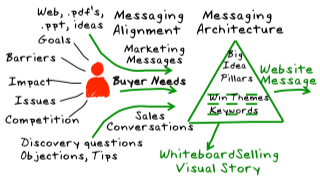 generate quality inbound leads and improve the effectiveness of sales conversations.
generate quality inbound leads and improve the effectiveness of sales conversations.
I recall running cold-calling technique workshops with early customers in 2004 in the UK and the US; we would set meetings with senior executives and I would accompany sales reps on those calls.
In our very first engagement I realized there was a bigger problem than getting the meeting. Salespeople could get in the door and were comfortable in conversing one or two levels below the decision level, but when they got in front of decision-makers, they struggled to engage the buyer around their business issues and would quickly revert to “product-speak”… a conversation about product features. The sales team had been well trained on the features and benefits of the product, but were uncomfortable in a business conversation around how buyers could use the product to create business value.
The meeting would end shortly thereafter, being thanked for our time and passed down to an underling. There were a couple of stars on the team who had figured out the value-creation conversation and could engage and they were the top performers, but the core group struggled.
From that moment on, sales and marketing messaging alignment has been a top priority deliverable to drive clarity in the conversations with buyers.
Matching Selling Process to Buying Behavior and Risk
Why Killer Product's Don't Sell author, Dominic Rowsell states that there are four, and only four buying cultures. Buying behavior varies according to organizational tolerance for risk. If you mismatch buying behavior, you risk failure in getting your killer product off the ground or overspending on customer acquisition cost.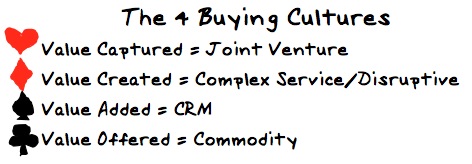
In larger companies a with a diverse product and services portfolio, a combination of all four buying behaviors can exist, requiring four different selling styles.
Selling to Customers how They Want to Buy
The IMPACT Cycle is the universal process of how B2B customers buy, governed by product maturity and risk tolerance. Understanding where and how to engage customers in the IMPACT cycle can help marketing and sales organizations lower the cost of customer acquisition. Sales approaches that disrupt status-quo thinking will be most effective when a sponsor in the buying organization is engaged at the Identify or Mentor phase.
The IMPACT Buying Cycle

Moving from Vendor to Trusted Adviser
What do Value-Created Selling, Challenger Selling, Corporate Visions Power Positioning sales approaches have in common? They use a disruptive sales approach, leading with relevant insight and opinions to help buyers think differently about their challenges and the ways of solving them.
Generally, the earlier the customer is engaged in the buying cycle, the greater the potential for the vendor to influence the outcome of the sale.
The Dell salesperson, (value-offered) is engaged when the buyer is ready to make a transaction. The Salesforce.com sales exec. (value-added) is engaged when the customer has assessed their needs and decides they are ready to look at a short list of CRM vendors.
The Value-Created sales person, Challenger or CVI trained Power Positioning salesperson or consultant, typically engages at the Mentor phase when the customer has no understanding of needs, only a sense of direction and a desire for insight on risk. Salespeople looking to disrupt status-quo thinking will engage at the Identify or Mentor phase of the buying cycle. In this way the salesperson becomes a valuable resource to the buying organization and is able to gain trusted adviser status.
Selling with Pictures - Visual Storytelling
For the past two years I have been working with Whiteboard Selling, either selling Whiteboard Selling services, creating whiteboard visual stories for technology company clients or running Whiteboard Selling Symposia. In that time, I've developed 25+ whiteboard stories and trained more than a thousand people how to tell their story. I've seen it work and I've lived it and I'm a huge believer in whiteboarding and visual storytelling....but I wanted to know why it works so well.
In these two years I have read more books on the brain and neuroscience than I have books on selling and have learned a ton about how we process information, make decisions and why it matters in selling. All of these books were interesting, some dense and hard going, but one stands out because it captures a lot of the ideas around getting your message to stick and getting people to change, in a fun, readable and relevant way... at least for me.
That book is Brain Rules, by John Medina. You can read an excellent precis here, with videos and illustrations on Squidoo.
Why Visual Storytelling Works - how to make your selling encounters more memorable
- The brain is a visual processing machine, with more than 50% of the brain dedicated to visual processing. In one study cited in the book, people could remember about 10% of what was delivered using spoken words after 72 hours; they could remember 35% of the pictures they saw after 72 hours, but they could remember a whopping 65% if the words and pictures were combined. Visual confections are powerful, you will see them on nearly every page in my Website.... a completed whiteboard story is a powerful visual confection.
- The prospect's brain checks out after 10 minutes, but you can keep grabbing them back by telling stories or creating events rich in emotion.
- The brain does not pay attention to boring things - so dump that crappy PowerPoint and start using simple images and story to engage buyers.
- Repeat to remember and remember to repeat
The more elaborately we encode a memory, the stronger it will be. When a salesperson is learning a new Whiteboard in a Whiteboard Selling Symposium, they will either see or do the whiteboard using all of their senses up to 9 times. Repetition over time is key to long term memory. That's why it is essential to follow any new skill development with coaching and role-playing on a regular basis. After a Whiteboard Symposium it is essential for sales managers to encourage and schedule whiteboard storytelling with their sales team back in the office.
- Multitasking is a dangerous myth The brain cannot do it....this is an important lesson for salespeople and motorists. Put the smartphone down when you are driving!
- Disrupting status-quo thinking requires big pictures, contrast and emotions. The new brain or neo-cortex loves to consume facts and
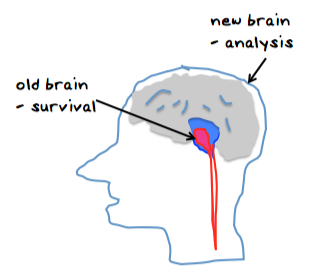 information and analyze stuff, but decisions about survival and change are made in the old brain... Seth Godin calls it the lizard brain.
information and analyze stuff, but decisions about survival and change are made in the old brain... Seth Godin calls it the lizard brain.
The old brain responds to contrast and emotions, big pictures and simple hand drawn images, (not metaphorical or borrowed interest photography).
In a selling situation, if you want someone to change what they are doing, you need to connect with the prospect's old brain to convince them that the status-quo is no longer safe and that your offering can help them achieve their goals, get things done and avoid the danger of failure.
Resources
Enterprise Lead Nurturing Guide
Killer Products Whitepaper
New Whiteboard Selling Whitepaper
Order Brain Rules on Amazon.com


